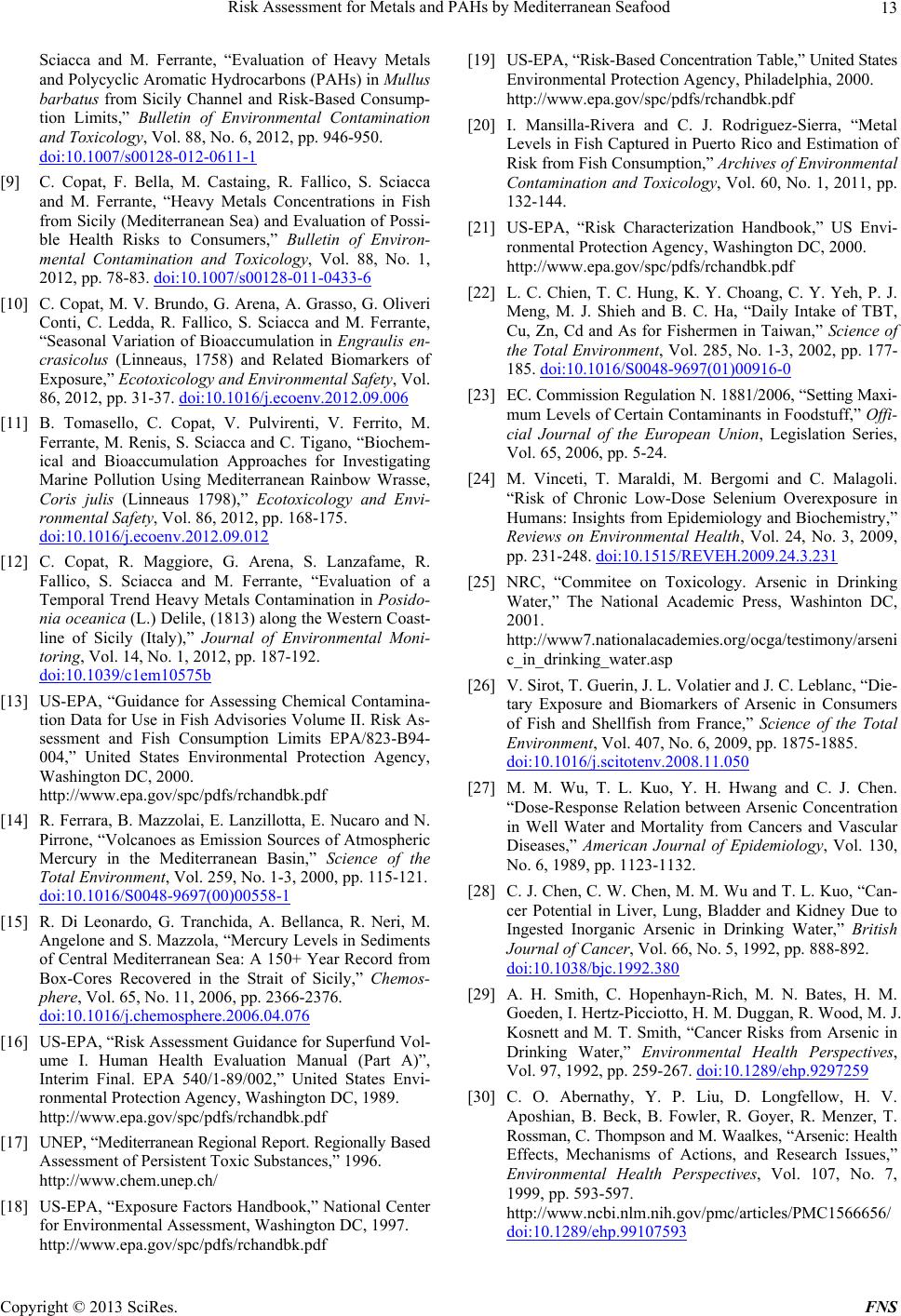
Risk Assessment for Metals and PAHs by Mediterranean Seafood
Copyright © 2013 SciRes. FNS
13
Sciacca and M. Ferrante, “Evaluation of Heavy Metals
and Polycyclic Aromatic Hydrocarbons (PAHs) in Mullus
barbatus from Sicily Channel and Risk-Based Consump-
tion Limits,” Bulletin of Environmental Contamination
and Toxicology, Vol. 88, No. 6, 2012, pp. 946-950.
doi:10.1007/s00128-012-0611-1
[9] C. Copat, F. Bella, M. Castaing, R. Fallico, S. Sciacca
and M. Ferrante, “Heavy Metals Concentrations in Fish
from Sicily (Mediterranean Sea) and Evaluation of Possi-
ble Health Risks to Consumers,” Bulletin of Environ-
mental Contamination and Toxicology, Vol. 88, No. 1,
2012, pp. 78-83. doi:10.1007/s00128-011-0433-6
[10] C. Copat, M. V. Brundo, G. Arena, A. Grasso, G. Oliveri
Conti, C. Ledda, R. Fallico, S. Sciacca and M. Ferrante,
“Seasonal Variation of Bioaccumulation in Engraulis en-
crasicolus (Linneaus, 1758) and Related Biomarkers of
Exposure,” Ecotoxicology and Environmental Safety, Vol.
86, 2012, pp. 31-37. doi:10.1016/j.ecoenv.2012.09.006
[11] B. Tomasello, C. Copat, V. Pulvirenti, V. Ferrito, M.
Ferrante, M. Renis, S. Sciacca and C. Tigano, “Biochem-
ical and Bioaccumulation Approaches for Investigating
Marine Pollution Using Mediterranean Rainbow Wrasse,
Coris julis (Linneaus 1798),” Ecotoxicology and Envi-
ronmental Safety, Vol. 86, 2012, pp. 168-175.
doi:10.1016/j.ecoenv.2012.09.012
[12] C. Copat, R. Maggiore, G. Arena, S. Lanzafame, R.
Fallico, S. Sciacca and M. Ferrante, “Evaluation of a
Temporal Trend Heavy Metals Contamination in Posido-
nia oceanica (L.) Delile, (1813) along the Western Coast-
line of Sicily (Italy),” Journal of Environmental Moni-
toring, Vol. 14, No. 1, 2012, pp. 187-192.
doi:10.1039/c1em10575b
[13] US-EPA, “Guidance for Assessing Chemical Contamina-
tion Data for Use in Fish Advisories Volume II. Risk As-
sessment and Fish Consumption Limits EPA/823-B94-
004,” United States Environmental Protection Agency,
Washington DC, 2000.
http://www.epa.gov/spc/pdfs/rchandbk.pdf
[14] R. Ferrara, B. Mazzolai, E. Lanzillotta, E. Nucaro and N.
Pirrone, “Volcanoes as Emission Sources of Atmospheric
Mercury in the Mediterranean Basin,” Science of the
Total Environment, Vol. 259, No. 1-3, 2000, pp. 115-121.
doi:10.1016/S0048-9697(00)00558-1
[15] R. Di Leonardo, G. Tranchida, A. Bellanca, R. Neri, M.
Angelone and S. Mazzola, “Mercury Levels in Sediments
of Central Mediterranean Sea: A 150+ Year Record from
Box-Cores Recovered in the Strait of Sicily,” Chemos-
phere, Vol. 65, No. 11, 2006, pp. 2366-2376.
doi:10.1016/j.chemosphere.2006.04.076
[16] US-EPA, “Risk Assessment Guidance for Superfund Vol-
ume I. Human Health Evaluation Manual (Part A)”,
Interim Final. EPA 540/1-89/002,” United States Envi-
ronmental Protection Agency, Washington DC, 1989.
http://www.epa.gov/spc/pdfs/rchandbk.pdf
[17] UNEP, “Mediterranean Regional Report. Regionally Based
Assessment of Persistent Toxic Substances,” 1996.
http://www.chem.unep.ch/
[18] US-EPA, “Exposure Factors Handbook,” National Center
for Environmental Assessment, Washington DC, 1997.
http://www.epa.gov/spc/pdfs/rchandbk.pdf
[19] US-EPA, “Risk-Based Concentration Table,” United States
Environmental Protection Agency, Philadelphia, 2000.
http://www.epa.gov/spc/pdfs/rchandbk.pdf
[20] I. Mansilla-Rivera and C. J. Rodriguez-Sierra, “Metal
Levels in Fish Captured in Puerto Rico and Estimation of
Risk from Fish Consumption,” Archives of Environmental
Contamination and Toxicology, Vol. 60, No. 1, 2011, pp.
132-144.
[21] US-EPA, “Risk Characterization Handbook,” US Envi-
ronmental Protection Agency, Washington DC, 2000.
http://www.epa.gov/spc/pdfs/rchandbk.pdf
[22] L. C. Chien, T. C. Hung, K. Y. Choang, C. Y. Yeh, P. J.
Meng, M. J. Shieh and B. C. Ha, “Daily Intake of TBT,
Cu, Zn, Cd and As for Fishermen in Taiwan,” Science of
the Total Environment, Vol. 285, No. 1-3, 2002, pp. 177-
185. doi:10.1016/S0048-9697(01)00916-0
[23] EC. Commission Regulation N. 1881/2006, “Setting Maxi-
mum Levels of Certain Contaminants in Foodstuff,” Offi-
cial Journal of the European Union, Legislation Series,
Vol. 65, 2006, pp. 5-24.
[24] M. Vinceti, T. Maraldi, M. Bergomi and C. Malagoli.
“Risk of Chronic Low-Dose Selenium Overexposure in
Humans: Insights from Epidemiology and Biochemistry,”
Reviews on Environmental Health, Vol. 24, No. 3, 2009,
pp. 231-248. doi:10.1515/REVEH.2009.24.3.231
[25] NRC, “Commitee on Toxicology. Arsenic in Drinking
Water,” The National Academic Press, Washinton DC,
2001.
http://www7.nationalacademies.org/ocga/testimony/arseni
c_in_drinking_water.asp
[26] V. Sirot, T. Guerin, J. L. Volatier and J. C. Leblanc, “Die-
tary Exposure and Biomarkers of Arsenic in Consumers
of Fish and Shellfish from France,” Science of the Total
Environment, Vol. 407, No. 6, 2009, pp. 1875-1885.
doi:10.1016/j.scitotenv.2008.11.050
[27] M. M. Wu, T. L. Kuo, Y. H. Hwang and C. J. Chen.
“Dose-Response Relation between Arsenic Concentration
in Well Water and Mortality from Cancers and Vascular
Diseases,” American Journal of Epidemiology, Vol. 130,
No. 6, 1989, pp. 1123-1132.
[28] C. J. Chen, C. W. Chen, M. M. Wu and T. L. Kuo, “Can-
cer Potential in Liver, Lung, Bladder and Kidney Due to
Ingested Inorganic Arsenic in Drinking Water,” British
Journal of Cancer, Vol. 66, No. 5, 1992, pp. 888-892.
doi:10.1038/bjc.1992.380
[29] A. H. Smith, C. Hopenhayn-Rich, M. N. Bates, H. M.
Goeden, I. Hertz-Picciotto, H. M. Duggan, R. Wood, M. J.
Kosnett and M. T. Smith, “Cancer Risks from Arsenic in
Drinking Water,” Environmental Health Perspectives,
Vol. 97, 1992, pp. 259-267. doi:10.1289/ehp.9297259
[30] C. O. Abernathy, Y. P. Liu, D. Longfellow, H. V.
Aposhian, B. Beck, B. Fowler, R. Goyer, R. Menzer, T.
Rossman, C. Thompson and M. Waalkes, “Arsenic: Health
Effects, Mechanisms of Actions, and Research Issues,”
Environmental Health Perspectives, Vol. 107, No. 7,
1999, pp. 593-597.
http://www.ncbi.nlm.nih.gov/pmc/articles/PMC1566656/
doi:10.1289/ehp.99107593